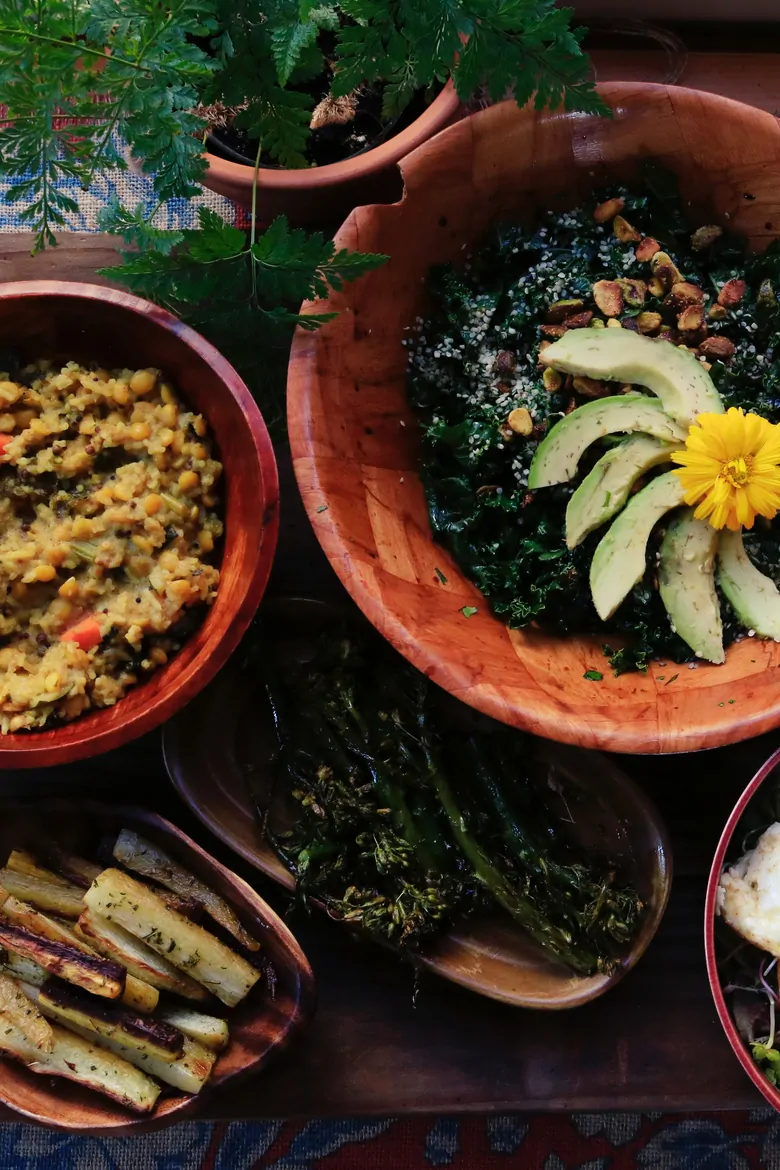What Is The Ayurvedic Diet?
Learn about one of the oldest traditional diets – The Ayurvedic Diet. Keeping in mind the limitations of scientific research, we aim to review this diet, without bias or judgment, and to learn what this 5,000-year-old traditional approach to healthy eating and living may offer.

As a registered dietitian, I’ve been engulfed in science for over 20 years. As much as I love science, I have also learned to be critical of it. Yes, you can do both.
In Western medicine, and particularly in the field of nutrition, recommendations are almost exclusively based on scientific evidence. New concepts and theories of how food affects our health has to be studied extensively by researchers before healthcare practitioners feel confident enough to make recommendations to the public or patients. This systematic approach to healthcare and medicine helps us figure out what approaches are both effective and safe. The value of evidence-based nutrition is indisputable, and as dietitians, we are expected to practice based on evidence.
Traditional and alternative approaches to healthy eating usually don’t fit into this idea of being “evidence-based”. Quite often, these alternative practices are not studied enough, and when they are studied, the quality of the research is usually questionable. This could be because they are difficult to study or because they are brushed off as having little value to merit funding for research.
Not to mention, the notion that randomized controlled trials (RCTs) are the gateway to “true knowledge” is unreasonable. RCTs are designed to investigate a given question in a given context – that in itself is a limitation. And let’s not forget, we can ask unwise questions – intentionally or obliviously.
No one denies that RCTs have their strengths, but this one-size-fits-all mentality is a problem in research. We know that certain information cannot be garnered from a RCT. Plus, inherent limitations are exacerbated due to biases in design, recruitment, sample populations and data analysis that are inevitable in real-world studies.

Why A Holistic Approach To Health Is Important
For many of us, we are relearning the ABCs of wellness. This journey of awakening typically begins with probing questions: what does happiness mean to me? What do I value in my life? Who am I? What’s my purpose? I think specializations in the field of science have made it difficult to take a holistic view of health and wellness. Some would argue that science falls short of tackling some of the more philosophical questions that some of us grapple with.
The more traditional approaches to wellness emphasize the connection between mind, body, and spirit. Some traditional diets and practices have been around for thousands of years – and many people do still follow them – with reported health benefits.
In this post, we will explore one of the oldest traditional diets – The Ayurvedic Diet. Keeping in mind the limitations of scientific research, our aim is to review this diet, without bias or judgment, and learn what this 5,000-year-old traditional approach to healthy eating and living may offer.
What is Ayurveda?
Ayurveda is a traditional medical practice that originated in India around 5,000 years ago. The word Ayurveda directly translates to the “science of life” in Sanksrit (“Ayur” means life and “Veda” means science).
In Ayurveda, health is considered to be the union of the body, mind, and consciousness. Every individual is born with a constitution – a unique combination of physical, mental and emotional characteristics. A person is regarded to be healthy when these characteristics are maintained in balance. However, emotional and physical stress throughout life, including following the wrong diet, can disturb this balance. And, to restore this balance, an individual must understand their dominant Dosha.
According to Ayurveda, everything in the world is made up of 5 elements: space, air, fire, water, and earth. These elements combine to make 3 Principle Energies or three “Doshas” of the body that determine a person’s metabolism, physical, and psychological functions. The three Doshas are Vata (space and air), Pitta (fire and water) and Kapha (earth and water).
What is the Ayurvedic diet?
The Ayurvedic diet suggests that eating according to your Dosha can help balance energy, provide the right nourishment for your body and promote weight loss.
Ayurvedic Foods
Ayurvedic food mainly includes sukha-rasa or easily digestible food. The proportion of easily digestible carbohydrates and proteins should be 50:50.
Ayurvedic food generally consists of vegetables, whole grains, lentils, beans and legumes (such as chickpeas), dairy products such as yogurt and milk, organic oils like coconut oil and olive oil and spices. Culinary herbs, such as turmeric and cardamom, are used in most dishes. Spices add a distinctive taste to Ayurvedic cooking.
Dal is a staple dish in most homes. It’s eaten with rice, roti (flatbreads) or even by itself depending on the type of dal eaten. Dal is also mixed with vegetables or whole grains and then cooked as a thick stew called kootu (South India) or upma (North India).
Traditional Indian cooking uses a lot of ginger, turmeric, garlic and freshly ground spices to create savoury flavours. Dried red chilli peppers are used often in Ayurvedic cooking, adding a distinct spicy taste to the food. These spices are thought to aid digestion and help balance Vata (wind) dosha in the body. The use of these herbs gives Indian food its unique character, colour and aroma.
Ayurvedic meals are usually divided into three parts: the main course, the side courses and the digestives.
To begin a meal in traditional Ayurvedic fashion, one may start with a cup of warm water or milk with a pinch of saffron, black salt (rock salt) or cumin powder. This drink is called panchamrut (“five nectars”). One teaspoon each of amalaki (Emblica Officinalis), shatavari (Asparagus racemosus) and haritaki (Terminalia chebula) can be added to the mixture. This drink is called triphala churnam, which helps to improve digestion.
In most Ayurvedic restaurants or households in India, a couple of side dishes are served along with the main course. A typical meal in most southern regions begins with rice, sambhar and rasam; a more central Indian meal may begin with bajra roti (millet bread) or chapati (unleavened whole-wheat bread), dal and curry. The northern regions of India favour puris (deep-fried puffed bread) as the bread with their meals and would have dal chawal (lentil curry over rice), a mixture of dals, vegetables and curd. Sometimes these are served in separate courses along with snacks called “chaat”.
At the end of a meal, the digestive course is served. This dish will help to eliminate any waste remaining in the stomach and restore the balance between Vata (air/wind) and Pitta (fire) doshas. An example of a digestive course is kichadi (“kitchari” in Hindi), which is made by boiling rice and mung beans together with spices and is eaten with ghee. A few more examples are khamang paani (buttermilk with cumin seeds), plain yogurt, a cup of hot water sweetened with jaggery (unrefined brown sugar) or pomegranate juice.
Chewing is considered to be a key aspect of an Ayurvedic lifestyle. Chewing your food thoroughly is referred to as “rasa shuddhi“, which means that when you chew the food it becomes a combination of taste (rasa) and energy (vayu) and can be assimilated into the body. This is why Ayurveda places tremendous emphasis on chewing your food thoroughly and not bolting down your meal.
In India, many Ayurvedic spas and health clinics are hotels with Ayurveda-trained experts who help people with their diet for weight loss, detoxification and other issues. These treatments and therapies focus on the mind/body connection in healing disease or achieving good health. These are different from the programs offered by many wellness and weight-loss resorts in North America, which may include treatments as massage, exercise, meditation, sauna or steam room sessions and colonic therapy.
What Ayurveda says about mealtimes
Ayurvedic eating is a holistic approach to healthy eating because the diet is thought to optimize your digestive fire. The concept of this ‘fire’ can be thought of as the strength and volume of stomach acid, enzymes, and bile in your gut. These juices work together to break down food into necessary building blocks for energy and proper nutrition not only does. The Ayurvedic lifestyle not only provides suggestions on what you should eat but also guides how you should eat so that these juice reactions are optimized:
- Include balanced tastes: Incorporate 6 “rasas” or tastes into every meal. The 6 “rasas” are sweet, salty, sour, bitter, pungent and astringent.
- Eat mindfully: Avoid distractions and focus attention on your meal
- Eat slowly: Take your time to savour your food
- Eat quickly: Eat at a pace that prevents food from getting cold
- Eat the right quantity: Honour your hunger and fullness cues
- Eat at the right times: Avoid eating until the previous meal has been digested. This means it is best to space meals at least 3-4 hours apart and to avoid going for 6 hours or more without eating.

Ayurvedic mealtime routines also include certain restrictions on food. Avoiding dairy products and legumes (such as beans, peanuts and soybeans) during certain times of the day is recommended to maintain a balance between Pitta (fire) and Vata (air/wind) doshas. This routine typically involves not consuming foods high in fat or protein during the latter half of the day. The AM meal is generally consumed before sunrise and the PM meal after sunset. In certain regions of India (such as Kerala), most meals are served at lunchtime and dinner is not served at all.
Does science support it?
A quick search of scientific databases further proves how little research has been done to explore the effectiveness of the Ayurvedic diet in improving health. The few studies that have been done have explored the potential role of Ayurveda in promoting diabetes management, coronary artery disease, and overall health behaviours. These studies are small and of poor quality. However, if you take a close look at the core components of the Ayurvedic diet, many of them are indeed backed by evidence.
- Mindful Eating– the practice of eating meals with awareness, intent and without judgment- is a relatively new and exciting area of research in the field of nutrition. Studies have shown that mindful eating may help with diabetes management, portion control, emotional eating, and following healthy eating patterns.
- Choosing whole and unprocessed foods- The Ayurvedic Diet emphasizes the importance of choosing whole foods that are minimally processed. This aligns with research that shows that diets high in processed foods can increase the risk of chronic diseases. In contrast, diets that are rich in unprocessed and minimally processed foods can lower the risk of chronic disease.
- Individualized nutrition (Prakriti): A key concept in Ayurveda is Prakriti or “individual nature”. Thus, personalized approaches to health and nutrition are central to Ayurveda and the Ayurvedic Diet. The scientific literature also shows that every individual has a unique metabolism based on their genes. This area of research, referred to as nutrigenomics, explores the possibility of prescribing personalized nutrition recommendations based on a person’s genes.
The Ayurvedic Diet includes a variety of whole foods and has a specific emphasis on plants such as fruits and vegetables, nuts and seeds, legumes and whole grains. There are many benefits to plant-based eating, not only for our health but also for the health of the planet. Plant-based eating patterns, including the Mediterranean diet, vegetarian diets, and the DASH diet have been shown to reduce the risk of chronic diseases like diabetes and heart disease.
Takeaway Message
While little scientific research has been done to study the Ayurvedic Diet, this ancient tradition offers many valuable lessons on healthy eating. Keep in mind that the Ayuverdic Diet can be restrictive, and may be difficult to sustain in the long term. Remember, the goal is to explore new ways of healthy eating, without over-restricting and eliminating foods that you enjoy. Eating according to your Dosha can be a great way to explore different foods and food combinations.








